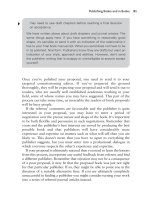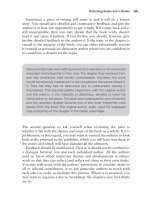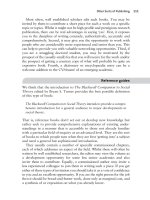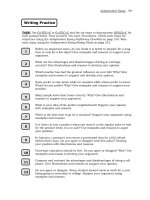Writing for Publication part 12
Bạn đang xem bản rút gọn của tài liệu. Xem và tải ngay bản đầy đủ của tài liệu tại đây (96 KB, 10 trang )
Sometimes a piece of writing will come in and it will be a horror
story. You should give detailed and constructive feedback and give the
author(s) at least one opportunity to get it right. If it comes back and is
still unacceptable, then you may decide that the book really doesn’t
need it and reject it politely. If you do this, you should, however, give
further detailed feedback to the author(s). If the topic of the chapter is
crucial to the integrity of the book, you can either substantially rewrite
it yourself or persuade an alternative author whom you are confident in
to contribute a chapter on the topic.
Rosa and Gertrude were editing a book that was likely to be extremely
important and influential in their area. The chapter they received from
one key contributor was wholly unacceptable. However, the book
would be seriously weakened if it did not address the issues raised in
it. They felt they had no alternative but to substantially rewrite it
themselves. This required careful negotiation with the original author
and the editors, in the interests of diplomacy, decided to leave his
name alone on the piece. The book was subsequently very influential
and the rewritten chapter became one of the most frequently cited
pieces from the book. The original author, sadly, used his supposed
sole authorship of the chapter to his career advantage.
The second question to ask yourself when reviewing the piece is
whether it fits with the themes and remit of the book as a whole. If it is
problematic in this regard, you may want to remind the authors to look
back at the proposal to the publisher, which you will have sent them at
the outset and which will have included all the abstracts.
Feedback should be multilateral. That is, it should not be confined to
a dialogue between you and each individual author. All the authors
need to know about important themes and developments in others’
work so that they can reflect (and reflect on) them in their own drafts.
You may well want, with the authors’ permission, to circulate drafts to
all or selected contributors or to put particular authors in touch with
each other in order to facilitate this process. Where it is practical, you
may want to organise a day to ‘workshop’ the chapters once first drafts
are in.
Publishing Books and in Books
101
Boden(3)-05.qxd 10/20/2004 6:00 PM Page 101
Pulling it all together
As the chapters start to be assembled in their final format, you need to
think about the editorial writing that you will do to wrap them all up
together. There are a number of ways of doing this and you will have
to judge what is the most appropriate for your book. You may decide
simply to have a detailed introduction that lays out the themes of the
following chapters and explains what is to come. In addition, you may
have decided (and proposed to the publishers) that the book should
have a final chapter written by the editor(s) that explicates, develops
and theorises the individual contributions. When you lay out your time
scales you must remember that you won’t be able to do this complicated
work until you have all the first drafts in.
Delivery and deliverance
Your final task as editor is to get the manuscript into the format
designated by the publisher. As with research monographs, you will
have the publisher’s style sheets from the publisher. This may appear to
be a small matter of detail, but it is vitally important that you deliver a
manuscript that complies as closely as possible with these stylistic
guidelines.
A way of saving yourself huge amounts of rather mundane and tedious
work at this stage is to ensure that you get hold of the publisher’s style
guidance early in the process and send it to your authors. You can then
politely require them to ensure that their own chapters are produced in
the appropriate form. This means that your job becomes one of checking
rather than reformatting – as you hope, though it doesn’t always happen
like that. You should also ask your authors to put their manuscripts into
whatever font you are working in, as you should send a good-looking
manuscript in, not one that looks like a dog’s breakfast.
Ensuring a happy ending
Whether you’ve written a monograph or edited a collection, the process
once the manuscript is in its final form is essentially the same. If you
Writing for Publication
102
Boden(3)-05.qxd 10/20/2004 6:00 PM Page 102
want your book to be published quickly and with good production
quality, then you need to continue to play your part promptly and
efficiently. This is what will happen:
Looking good
You need to send the publisher a hard copy (sometimes two) and an
electronic copy of the whole book, in the style that they have asked
for, with pages numbered appropriately and so on. We cannot over-
emphasise the importance of making the text as good and consistent as
you possibly can.
Readers’ comments
Sometimes your book will be sent out for readers’ comments at this
stage. This will have been made clear to you at the contract stage. If this
is the case, then you may be asked to make some revisions to content or
approach and you will then have to respond to the suggestions made.
You should look back at what we said above about responding to
referees’ comments on journal articles to help you with this.
Copy editing
All books will be subject to copy editing. Copy editors read for things
like the formatting of the manuscript, diagrams, grammar, spelling,
punctuation, clarity of meaning and the accuracy of citations and
references. Sometimes they will return the whole manuscript to you
with their comments and a letter asking you to look at particular pages
and queries. Often they will send you only the pages on which they have
suggested alterations.
Whichever, when you get the manuscript back, you will need to
respond to their comments and queries quickly but being extremely
careful in the way you review the proposed changes. Copy editors are
not experts in your field and sometimes they may propose alterations
that inadvertently change the meaning of what you have written.
If you are editing a collection, you should ask contributing authors to
check their own copy-edited articles, but beware of the slow response.
Make sure that you give authors a firm deadline for returning their
comments to you and that they know that, whether you have heard
from them or not, you will be replying to the copy editor by a particular
Publishing Books and in Books
103
Boden(3)-05.qxd 10/20/2004 6:00 PM Page 103
date. The fact that you have sent copy to individual authors does not
excuse you, as editor, from your responsibility for checking the copy
editing of all the chapters, so do it for the whole book regardless of
what you send to your contributors.
Covering yourself
Although you are not supposed to judge a book by its cover, most
people do. It is therefore very important to pay careful attention to
what your finished book as a ‘product’ is going to look like on the
shelves. You should be able to negotiate the type of cover with the
publisher. If you have seen books in their catalogue that have a
particularly good cover you should tell your editor, as it will enable
them to commission the same designer. Bear in mind, though, that if
you wish to use a photograph, original artwork or anything else which
might carry somebody’s copyright, then you will need to ensure that
you have the necessary copyright clearance (and this might involve
paying a fee).
Once the publisher has the manuscript and has accepted it, they will
then commission a cover design. Publishers will often send you a few
(maybe three or four) possible covers for your comments. Again, you
need to respond as quickly and constructively as possible. It won’t help
the publisher if you just say that you hate that cover without saying
why. If your book is one of a series, your cover will follow the series
design, though it is likely that there will be some room for individuality
within it.
In nearly all cases, you will be asked to provide the cover ‘blurb’ – the
text for the back of the book. This text will also be replicated in the
publisher’s catalogue, other publicity materials and on e-booksellers’
websites. It is therefore important that it is both accurate and enticing
for the reader.
Once the cover design has been finalised, the publisher will send
you ‘proofs’ (that is, an exact version of what the final thing will look
like on the page) of your cover. This will require your careful
attention, as it will also include the blurb and also any information,
usually about yourself, that will go on the inside flaps of any dust
jacket. You may also have been asked by the publisher to provide
them with the names of reputable commentators in your field who
might be willing to be quoted on the back of your book and in other
publicity material.
Writing for Publication
104
Boden(3)-05.qxd 10/20/2004 6:00 PM Page 104
Page proofs
At about the same time as you get possible covers, you are likely to be
sent the page proofs of your book for proof reading. Publishers like to
produce proofs that are as close as is reasonably practicable to the final
printed product. Their chief concerns will be to ensure that the
pagination of the text is not altered at this stage – inserting a paragraph,
or even a sentence, on page 17 of a 200 page book may create 183
consequential page changes. This is very costly and if you insist on such
changes at that stage the publisher may charge you for the extra work
caused. This is, therefore, definitely not the time to make final revisions.
But it is your last chance to ensure that there are no errors in the final
text. Publishers have standard codes and symbols for each change that
you might want to make (such as deletions, insertions, spelling correc-
tions, the use of upper or lower case) and they will be able to supply you
with a list of them or direct you to where you can find them. Use them,
as it avoids confusion in making the corrections.
Indexes
Once you have the page proofs, you will also need to get the index
sorted out. Usually, publishers will offer you the choice of doing the
index yourself or commissioning a professional indexer. If you choose
the latter, the payment to the indexer will come out of your royalties.
There are advantages and disadvantages both to doing the index
yourself and to getting a professional to do it. If you do it yourself, you
can ensure that you have a proper index that reflects what you judge to
be the key themes, topics and issues in the book. Like copy editors,
indexers are seldom experts in your field so they can’t necessarily make
judgements about the importance of particular themes as easily or
accurately as you can. However, it is also a very time-consuming task
to do yourself and you will be slower than a professional.
If you choose to do your own index, you cannot rely on technology
to do it for you. Computer programmes can find words and phrases but
they can’t make important decisions for you. For example, they can’t
judge whether the same concept is carried through several successive
pages or not. Neither can they identify a concept if the phrase you have
given the computer doesn’t appear in that exact form. Often publishers
will have guidelines about how they like an index to be compiled. If they
do, make sure you follow their advice.
Publishing Books and in Books
105
Boden(3)-05.qxd 10/20/2004 6:00 PM Page 105









